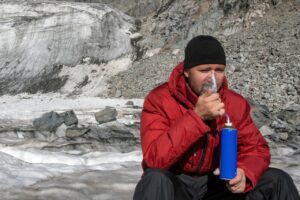Could you get altitude sickness at your local ski resort? |

As they say in Game of Thrones, “winter is coming.” Time to break out the snow gear and prepare for mountain sports (or find some dragon glass to fight off the white walkers – your choice). If you’re planning a trip out west to Colorado, New Mexico, or Utah, however, you may need to think about altitude sickness.
Altitude sickness is also known as “acute mountain sickness” or AMS, and it’s caused by lower oxygen levels at higher elevations. AMS gives symptoms similar to a hangover – headache, nausea, dizziness, poor sleep, and fatigue. Most people are not affected by AMS until the altitude is greater than 2,500 meters or 8,200 feet, however, there is wide (and sometimes unpredictable) variation in when and how severely symptoms are felt. Those with kidney, lung, or heart disease may experience symptoms at lower elevations. Some people are genetically predisposed to AMS as their bodies do not adjust as quickly to lower oxygen levels. In moderate altitude (2000-3500 meters or 6,550-11,482 feet) ski resorts, about 10-40% of people experience AMS symptoms.
When AMS becomes more severe (more common at very high altitudes: 3500-5600 meters or 11,200-18,000 feet) it can result in two life-threatening syndromes, causing rapid swelling in the lungs and brain.
High-altitude pulmonary edema (HAPE) is the lung’s response to low oxygen pressure over time. Breathing rate, heart rate, and blood pressure all increase as the body attempts to draw in and circulate more oxygen. Interestingly, the lung tissue’s response to low oxygen is to clamp down its arteries. With the increased blood flow coming into the lungs, and tight vessels inside, fluid is forced out into the tissue causing swollen lungs that are less effective at oxygen exchange. This can cause suffocation and death in its most severe form.
High-altitude cerebral edema (HACE) occurs when rapid changes in adrenaline (triggered by low oxygen in the air) result in elevations in blood pressure that can swell the brain. Symptoms include changes in personality, emotional outbursts, severe headache, violence, ataxia (discoordination), then drowsiness and eventual coma. Once a coma has developed, death may occur from brain herniation. The usual course is rapid, complete recovery if descent is immediate and treatment is started promptly.
How does the body adjust to higher altitudes?
It takes about 4 days for the body to adjust to lower oxygen levels. It does this by producing more red blood cells to carry oxygen throughout the body, and the kidneys play a major role in adjusting the pH of the bloodstream. When your breathing rate increases, you expel more carbon dioxide (and natural body acid). The kidneys respond by excreting bicarbonate in the urine to balance the acid loss in your breath, reducing the trigger to breathe rapidly and restoring a normal pH.
How can you reduce your risk of AMS?
Ascending no more than 500m (1,640 feet) per day is the best way to become acclimatized to a high altitude. If you do not have the time for this, some medicines may be helpful.
There is a diuretic medicine called acetazolamide which triggers the kidneys to excrete bicarbonate. Taking this early on can jump start the pH balancing that your body needs to accomplish at higher altitudes. Drinking plenty of water is important to replace the losses as well.
In cases where HAPE and HACE may occur, rapid descent is the best treatment and may resolve the problems within hours. If this is not possible, steroids such as dexamethasone may reduce swelling. Supplemental oxygen is also useful.
Which U.S. ski resorts have the highest elevations?
Sixteen of the top twenty highest elevation ski resorts in the U.S. are in Colorado. Three are in New Mexico, and one in Arizona. For a full list of ski resorts and their elevations, click here: http://www.skiresort.info/ski-resorts/north-america/sorted/mountain-altitude/
The top 5 highest altitude resorts (all with elevations greater than 12,000 feet) are:
• Breckenridge
• Loveland
• Telluride
• Snowmass
• Taos
So don’t be surprised if you feel yucky for the first few days of your ski vacation. Try to ease into the high elevation, and take along some acetazolamide to combat AMS. The fastest way to feel better, of course, is to get back down to sea level!
References
http://www.altitude.org/altitude_sickness.php
https://emedicine.medscape.com/article/768478-overview#a4
If you have any more questions just Ask Hanna, our health advisors are here to help.
Image: ©Shutterstock / Kirill Skorobogatko








